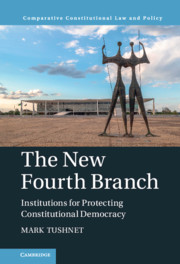Book contents
- The New Fourth Branch
- Comparative Constitutional Law and Policy
- The New Fourth Branch
- Copyright page
- Contents
- Acknowledgments
- 1 Introduction
- 2 Why a Fourth Branch?
- 3 Why a Fourth Branch?
- 4 Design Issues in General
- 5 Design Principles in Practice
- 6 Anti-corruption Investigations
- 7 Electoral Commissions
- 8 Audit Agencies
- 9 Conclusion
- Index
8 - Audit Agencies
Published online by Cambridge University Press: 20 August 2021
- The New Fourth Branch
- Comparative Constitutional Law and Policy
- The New Fourth Branch
- Copyright page
- Contents
- Acknowledgments
- 1 Introduction
- 2 Why a Fourth Branch?
- 3 Why a Fourth Branch?
- 4 Design Issues in General
- 5 Design Principles in Practice
- 6 Anti-corruption Investigations
- 7 Electoral Commissions
- 8 Audit Agencies
- 9 Conclusion
- Index
Summary
Audit agencies are among the oldest fourth-branch institutions. Their primary mission has always been to track the use of public money. Sometimes the payments are “merely” wasteful: the official making them paid too much because he did not take the time to look for cheaper sources of the goods or services. Here auditors detect government inefficiency. At other times, auditors detect some important forms of fraud: payments to cronies and payments for work not done, for example.1
- Type
- Chapter
- Information
- The New Fourth BranchInstitutions for Protecting Constitutional Democracy, pp. 158 - 172Publisher: Cambridge University PressPrint publication year: 2021
- 1
- Cited by

